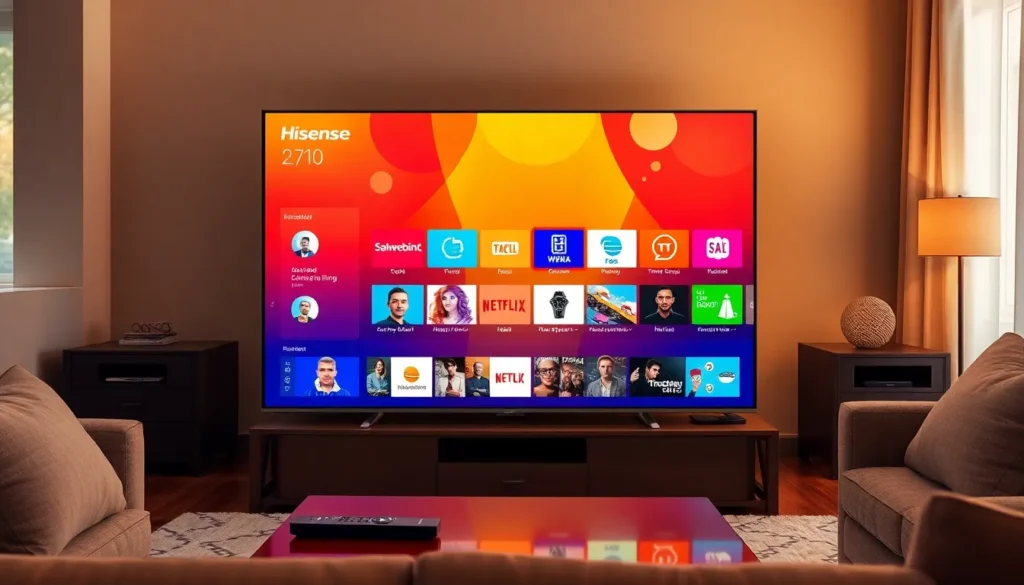In a world where cash is becoming as rare as a unicorn sighting, peer-to-peer (P2P) payment apps have swooped in like superheroes to save the day. These nifty little apps let people send and receive money faster than you can say “dinner’s on me!” Gone are the days of fumbling for change or writing awkward IOUs. With just a few taps on a smartphone, splitting the bill or paying back a friend has never been easier—or more fun.
Table of Contents
ToggleOverview of P2P Payment Apps
P2P payment apps facilitate seamless money transfers between individuals, eliminating the need for cash or checks. These apps allow users to send and receive funds instantly using smartphones. Key features include user authentication, transaction history, and sometimes, even rewards programs. Popular options include Venmo, PayPal, and Cash App, each offering unique functionalities and user experiences.
Security remains a primary concern. Most P2P payment apps employ encryption, two-factor authentication, and secure servers to protect user data. This emphasis on security builds trust among users, enabling widespread adoption.
Ease of use significantly contributes to their popularity. Users typically link their bank accounts or debit cards, allowing for quick transactions. Furthermore, split bill features enhance collaboration among friends while dining out or sharing expenses.
Adoption rates continue to rise as more people embrace cashless transactions. A recent survey showed that 80% of millennials utilize at least one P2P payment app. This demographic shift indicates a broader acceptance and reliance on digital payment solutions.
Transaction limits vary by app. For example, Venmo caps transactions at $4,999 for its standard services, while Cash App has a weekly limit of $7,500. Understanding these limits helps users choose the right app for their needs.
Integration with other financial services also plays a role. Many P2P payment apps allow users to send funds to businesses or even pay for services directly. This versatility positions P2P apps as essential tools in today’s digital economy.
Popular P2P Payment Apps

P2P payment apps provide users with a simple way to send and receive money. Various options cater to different needs, focusing on convenience, security, and features.
Venmo
Venmo stands out for its social networking element, allowing users to share payment activities with friends. Partnered with PayPal, it ensures secure transactions via encryption. Users can connect bank accounts or debit cards for quick transfers. Venmo also features customizable payment notes, enhancing interaction. With a limit of $299.99 for instant transfers, Venmo appeals to millennials, particularly for casual transactions like splitting dinner bills.
Cash App
Cash App offers a unique angle with its investment features, allowing users to buy stocks and Bitcoin directly. Instant transfers make it a preferred choice for many. Security remains top-notch due to its use of encryption and optional Cash Card for spending funds. Users face a limit of $1,000 per 30 days for sending money, aligning with casual use patterns. Cash App’s integration with direct deposits makes it popular among freelancers and gig workers.
Zelle
Zelle excels in bank integration, allowing seamless transfers directly from users’ bank accounts. Many major banks support Zelle, which facilitates quick money movement without needing external accounts. Funds typically arrive within minutes, enhancing its appeal for urgent payments. Users maintain control with built-in security features, including two-factor authentication. Zelle has no fees for transactions, making it a straightforward option for sending money to family and friends.
Security Features of P2P Payment Apps
Security remains critical for P2P payment apps. Strong measures protect users and their financial data.
Encryption
Encryption methods safeguard sensitive information. Many apps utilize advanced encryption protocols to secure transactions, making unauthorized access nearly impossible. For instance, encryption protects details during both data transfer and storage. Robust encryption minimizes the risk of data breaches, fostering trust in users. By ensuring that data remains confidential, payment apps can maintain user loyalty and encourage further adoption.
User Authentication
User authentication systems enhance security measures significantly. Most P2P payment apps require multi-factor authentication to verify user identities. This might include biometric data, such as fingerprints or facial recognition, alongside traditional passwords. Strong user authentication prevents unauthorized account access, which is essential given the sensitive nature of financial information. Incorporating these security features helps users feel more secure and confident while conducting financial transactions through various platforms.
Benefits of Using P2P Payment Apps
P2P payment apps offer numerous advantages that appeal to a wide range of users. Convenience ranks among the top benefits. Individuals can transfer money seamlessly using their smartphones, which eliminates the need for cash or checks.
Speed also plays a crucial role in these platforms. Sent funds reach recipients almost instantly, facilitating quick bill splits or reimbursements. Users appreciate having quick access to their funds without waiting for traditional bank transfers.
Low transaction fees attract users too. Many P2P apps do not charge fees for personal transactions, making them cost-effective options for everyday payments. Those looking to avoid high charges often find these platforms suitable for their financial activities.
Security features stand out as significant advantages. Robust encryption methods protect user data during transfers. Multi-factor authentication helps ensure that only authorized users access their accounts, reinforcing trust among users.
Integration into daily life enhances user experience. Many P2P apps link with bank accounts or debit cards, simplifying the payment process. Users frequently enjoy additional functionalities, such as transaction history or rewards programs, which add value to their transactions.
Adaptability is another key benefit. P2P payment apps cater to different user preferences, with options like social sharing on Venmo and investment opportunities on Cash App. Varied functionalities allow users to choose an app that aligns with their specific needs.
Overall, quick, convenient, and secure transactions define the appeal of P2P payment apps. These benefits contribute to the increasing adoption within society, particularly among millennials, who show a strong preference for digital payment solutions.
Future Trends in P2P Payment Technology
Emerging trends in P2P payment technology indicate an ongoing evolution in user experience and functionality. Adoption of cryptocurrencies is gaining momentum, with many apps likely to incorporate options for digital currencies. Venmo and Cash App are already exploring this integration, making it easier for users to access a wider range of financial assets.
Artificial intelligence is playing a significant role in enhancing security features. AI-driven algorithms can analyze transaction patterns to identify fraudulent activities. This proactive approach increases user trust, encouraging more people to adopt P2P payment methods.
Blockchain technology is set to revolutionize P2P payments with its decentralized nature. This innovation can facilitate quicker and cheaper transactions without intermediaries. Vendors and users alike benefit from reduced fees and improved transaction speeds, contributing to a faster payment ecosystem.
Compliance with regulatory standards is crucial as the P2P payment landscape grows. Apps must continuously adapt to maintain security and privacy for users. Companies prioritizing regulatory compliance can foster greater consumer trust and loyalty.
User interface advancements are improving the overall experience. Simplified designs and more intuitive navigation make P2P payment apps more accessible to users of all ages. Enhanced user experiences often lead to increased adoption rates, particularly among tech-savvy millennials.
Collaboration with traditional financial institutions is another trend to watch. Partnerships enable P2P platforms to tap into existing infrastructures for seamless fund transfers. Users appreciate these alliances, as they often translate into enhanced services and better financial solutions.
Overall, the future of P2P payment technology is bright, marked by innovation and continuous improvement. As these trends unfold, users will benefit from increased convenience, enhanced security, and broader access to financial services.
P2P payment apps have undeniably reshaped the landscape of personal finance. Their convenience and efficiency cater to the fast-paced lifestyle of today’s users. As technology continues to evolve, these apps are likely to incorporate even more innovative features that enhance user experience and security.
With strong adoption rates among younger generations, P2P payment platforms are set to become a staple in everyday transactions. The ongoing commitment to security measures and user-friendly designs will further drive their popularity. As society moves toward a more digital economy, embracing these tools will be essential for both individuals and businesses alike.













